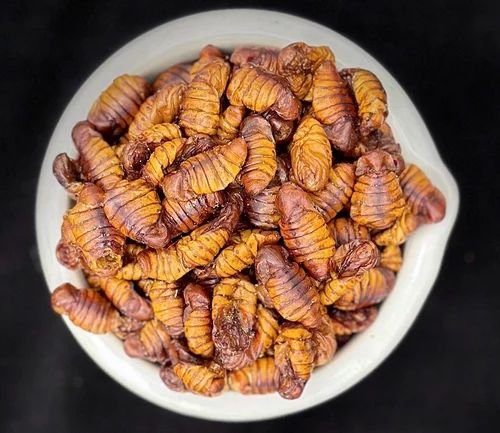
You might be wondering why silkworm pupae are gaining attention as an animal feed option. The truth is, they’re rich in protein, fats, vitamins, and minerals, making them a fantastic alternative to traditional feed ingredients. So, settle in with your favorite beverage, and let’s dive into the fascinating world of silkworm pupae and why they’re becoming a go-to choice for animal nutrition.
What Are Silkworm Pupae?
Silkworm pupae are the larvae of the Bombyx mori moth. After going through several stages of development, known as instars, the silkworms spin cocoons made of silk. Once they transform into pupae, they can be harvested. Instead of being discarded, these pupae are increasingly recognized for their nutritional value. It’s like turning something once deemed a waste product into a treasure chest of nutrients.
In terms of nutritional composition, silkworm pupae are incredibly rich in protein, containing about 38–45% protein on a dry weight basis. This means that by including silkworm pupae in animal feed, farmers can provide their livestock with a concentrated source of essential amino acids, which are crucial for growth and health. When compared to traditional protein sources, silkworm pupae stand out not just for their nutrient content but also for their digestibility.
The Nutritional Benefits of Silkworm Pupae
Why should farmers consider incorporating silkworm pupae into their animal feed? The answer lies in their rich nutritional profile. For starters, they’re packed with high-quality protein. This makes them an excellent alternative for young, growing animals that need plenty of protein to develop properly.
Here are some of the standout nutrients found in silkworm pupae:
- Protein: Between 38–45% protein content.
- Fats: Healthy fats, including omega-3 and omega-6 fatty acids.
- Vitamins: Rich in vitamin B12 and other B vitamins which are vital for metabolism.
- Minerals: Contains essential minerals like calcium, iron, and zinc.
By feeding livestock silkworm pupae, farmers can not only improve the overall health and growth rates of their animals but also potentially reduce the need for additional supplements. Honestly, it’s like hitting a protein jackpot!
Environmental Impact of Using Silkworm Pupae
With growing concerns about the environmental impact of traditional animal feed sources, silkworm pupae offer a more sustainable alternative. Rearing silkworms typically requires less land and water compared to conventional livestock farming. They’re efficient at converting feed into protein, meaning you get more output with fewer resources.
Additionally, because silkworms can be raised on agricultural byproducts like mulberry leaves, they help in reducing waste, closing the loop within agricultural systems. This minimizes the ecological footprint of animal production and allows farmers to play their part in promoting a more sustainable food system.
By thinking about feed options like silkworm pupae, we’re not just considering better nutrition for our animals, but we’re also taking steps toward a healthier planet. It’s a win-win!
How to Incorporate Silkworm Pupae into Animal Diets
If you’re interested in using silkworm pupae for animal feed, it’s important to know how to incorporate them correctly. They can be used in various forms, whether dried, powdered, or as part of a complete feed formulation.
Here’s a simple guide on how to do it:
1. Consult an Expert: Before making any changes to animal diets, it’s always a good idea to consult with a veterinarian or an animal nutritionist. They can help determine the right amount for your specific livestock needs.
2. Start Gradually: Introduce silkworm pupae slowly to your animals’ diets. This helps their digestive systems adjust and prevents any tummy troubles.
3. Mix with Other Feed: Rather than replacing existing feed entirely, mix silkworm pupae with other feed ingredients. This will help ensure a balanced diet while allowing your animals to benefit from the added protein.
4. Monitor Health: Keep an eye on the animals’ health and growth rates. If you notice improvements, you might want to consider increasing the amount.
By following these steps, you can start harnessing the power of silkworm pupae in your animal feed today.
Comparing Silkworm Pupae to Traditional Proteins
You might be wondering how silkworm pupae stack up against more commonly used protein sources like soy or fish meal. Let’s break down some key differences and advantages.
– Nutritional Value: Silkworm pupae are richer in certain essential amino acids compared to soy, making them a more complete protein for livestock.
– Sustainability: Traditional feed sources often require extensive land and water resources. Silkworm pupae can be produced with far less environmental impact, making them a more sustainable choice.
– Digestibility: Animals often digest silkworm pupae more efficiently, leading to better absorption of nutrients and overall health.
Saying that silkworm pupae are the best option for everyone might be an oversimplification, as farmers need to choose what works best for their specific operations. But considering the nutritional and environmental benefits, silkworm pupae are certainly worth a closer look.
The Future of Silkworm Pupae in Animal Feed
As more farmers seek sustainable and nutritious alternatives, the future looks bright for silkworm pupae in the animal feed industry. Research is ongoing to further understand the benefits and optimize their use. With advancements in farming techniques and increased awareness of the environmental impact of feed production, we’re likely to see a significant rise in the use of silkworm pupae.
The conversation surrounding animal feed is changing, and silkworm pupae are leading the charge. By embracing innovative solutions, we can create a more sustainable agricultural system that supports both livestock health and environmental integrity.
In conclusion, silkworm pupae stand out as an exciting and nutritionally-rich protein source for animal feed. They not only offer essential nutrients required for livestock growth but also contribute to more sustainable farming practices. As we look toward the future, considering alternatives like silkworm pupae could represent a significant step forward in how we think about feeding our animals—and ultimately, how we feed the world.

